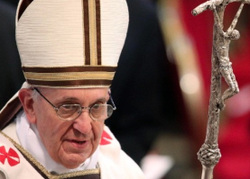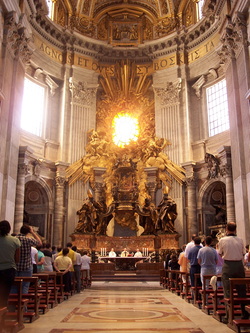
Like the stunned crowd gathered below the papal balcony, my initial reaction to Jorge Cardinal Bergoglio’s election as Pope Francis, was “Who?” And while the early weeks of papacy are giving us a clearer image of his leadership, we can also surmise some things from his ministry in Argentina before his election to the Chair of Peter.
Consider an interview he gave in July 2011, especially his response when asked about the laity in his country: “There are lay people who actually live their faith seriously, they believe that Jesus is alive and hope in the resurrection, but meanwhile they’re not sitting around scratching their bellies, as Chileans say, but working, expecting the Lord to come and preparing the way.”
Reading between the lines, I suppose he also means that there are at least some lay people who actually are “sitting around scratching their bellies.” Ouch.
The Cardinal continued, “There is a problem…the temptation to clericalism. Priests tend to clericalize the laity. And the laity, not all but many, ask us on their knees to clericalize them because it is more comfortable to be an altar boy than to truly live out the lay vocation.”
We’re all familiar with “clericalism,” in practice if not in terminology, which can consist of a neglect of the particular dignity and vocation of the laity within the Church, and an unhealthy emphasis on ordination as a status of superiority rather than service.
But what does clericalism mean in this context, this idea of priests tending to “clericalize the laity,” and per the laity’s request! The Cardinal’s comments suggest is that there is a danger in believing that the only true ministry of the Church occurs at the altar, and that our dignity as laity consists exclusively in helping the ordained priest in his priestly service.
The Cardinal explains, “The lay person is a lay person and has to live like a lay person with the strength of baptism, which renders him capable of being leaven of God’s love in society itself …carrying the cross like we all do. The lay person’s cross, not the priest’s cross. Let the priest carry the priest’s cross. God gave him shoulder enough to bear it.”
A few columns ago, I pointed out that the Catechism, in describing the common priesthood (laity) and the ministerial priesthood, states, “the ministerial priesthood is at the service of the common priesthood. It is directed at the unfolding of the baptismal grace of all Christians.” As I noted, we often view the situation in reverse, thinking the laity exists to serve the ordained. But the source of confusion is not who you think. In fact, despite the kvetching and priest-bashing common among Catholics, this form of clericalism is fostered more by laity than by priests, either because we like the safety of being altar servers only, or because it’s easier to do nothing.
I’m convinced that the new evangelization—the fresh and bold proclamation of the good news of Christ’s redeeming love—will be accomplished primarily through laity who embrace their baptismal mission and ministry in the secular world, doing ministry not within the walls of the Church but out in the world, among people who would never think to walk into an RCIA class.
Consider the work of the Catholic Action Center here in Lexington, begun by lay people who embraced the vision of the Catholic Worker movement. Or consider Ruah Woods (see ruahwoods.org), a lay teaching apostolate in the Cincinnati area dedicated to promoting Blessed John Paul II’s Theology of the Body within all age groups. Their ministry was initiated and funded entirely by lay persons who saw a need and stepped up to fulfill it. While the ministry has the blessing of the Archbishop, it requires no diocesan staff or funding.
When we as laity see a direct ministry need through our own particular eyes, rather than wait upon our pastors to act (they’re already carrying their own demanding cross), and rather than wait on a diocesan initiative (where staff and resources are limited), we must step up to the task; not as lone rangers, but in cooperation with others we might gather. And while we must seek the blessing and guidance of our pastor and Bishop, we should not depend upon their assistance.
Only when we prefer our baptismal mission to belly-scratching will the power of the new evangelization be released. The time is now—are we ready?
Consider an interview he gave in July 2011, especially his response when asked about the laity in his country: “There are lay people who actually live their faith seriously, they believe that Jesus is alive and hope in the resurrection, but meanwhile they’re not sitting around scratching their bellies, as Chileans say, but working, expecting the Lord to come and preparing the way.”
Reading between the lines, I suppose he also means that there are at least some lay people who actually are “sitting around scratching their bellies.” Ouch.
The Cardinal continued, “There is a problem…the temptation to clericalism. Priests tend to clericalize the laity. And the laity, not all but many, ask us on their knees to clericalize them because it is more comfortable to be an altar boy than to truly live out the lay vocation.”
We’re all familiar with “clericalism,” in practice if not in terminology, which can consist of a neglect of the particular dignity and vocation of the laity within the Church, and an unhealthy emphasis on ordination as a status of superiority rather than service.
But what does clericalism mean in this context, this idea of priests tending to “clericalize the laity,” and per the laity’s request! The Cardinal’s comments suggest is that there is a danger in believing that the only true ministry of the Church occurs at the altar, and that our dignity as laity consists exclusively in helping the ordained priest in his priestly service.
The Cardinal explains, “The lay person is a lay person and has to live like a lay person with the strength of baptism, which renders him capable of being leaven of God’s love in society itself …carrying the cross like we all do. The lay person’s cross, not the priest’s cross. Let the priest carry the priest’s cross. God gave him shoulder enough to bear it.”
A few columns ago, I pointed out that the Catechism, in describing the common priesthood (laity) and the ministerial priesthood, states, “the ministerial priesthood is at the service of the common priesthood. It is directed at the unfolding of the baptismal grace of all Christians.” As I noted, we often view the situation in reverse, thinking the laity exists to serve the ordained. But the source of confusion is not who you think. In fact, despite the kvetching and priest-bashing common among Catholics, this form of clericalism is fostered more by laity than by priests, either because we like the safety of being altar servers only, or because it’s easier to do nothing.
I’m convinced that the new evangelization—the fresh and bold proclamation of the good news of Christ’s redeeming love—will be accomplished primarily through laity who embrace their baptismal mission and ministry in the secular world, doing ministry not within the walls of the Church but out in the world, among people who would never think to walk into an RCIA class.
Consider the work of the Catholic Action Center here in Lexington, begun by lay people who embraced the vision of the Catholic Worker movement. Or consider Ruah Woods (see ruahwoods.org), a lay teaching apostolate in the Cincinnati area dedicated to promoting Blessed John Paul II’s Theology of the Body within all age groups. Their ministry was initiated and funded entirely by lay persons who saw a need and stepped up to fulfill it. While the ministry has the blessing of the Archbishop, it requires no diocesan staff or funding.
When we as laity see a direct ministry need through our own particular eyes, rather than wait upon our pastors to act (they’re already carrying their own demanding cross), and rather than wait on a diocesan initiative (where staff and resources are limited), we must step up to the task; not as lone rangers, but in cooperation with others we might gather. And while we must seek the blessing and guidance of our pastor and Bishop, we should not depend upon their assistance.
Only when we prefer our baptismal mission to belly-scratching will the power of the new evangelization be released. The time is now—are we ready?


 RSS Feed
RSS Feed
